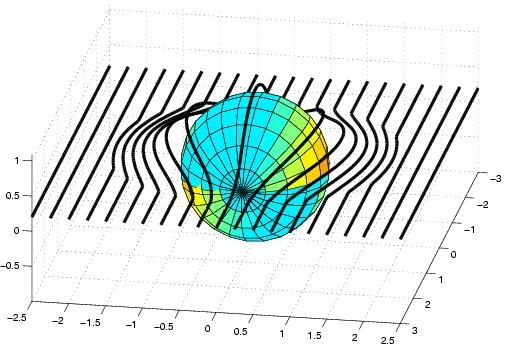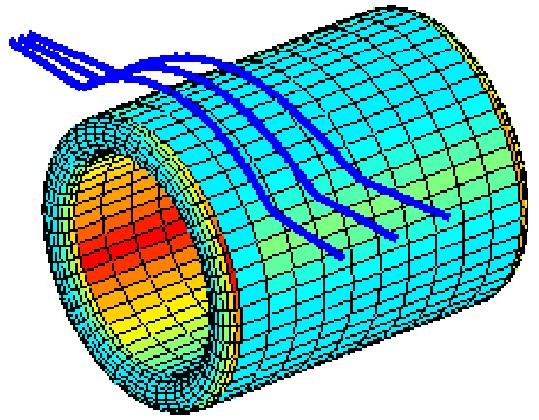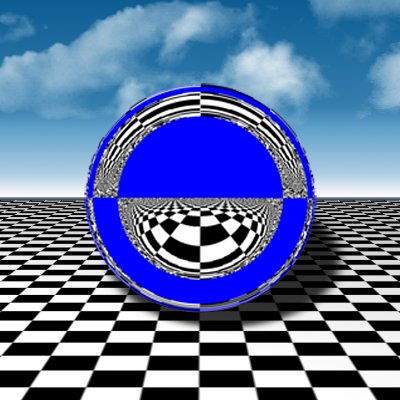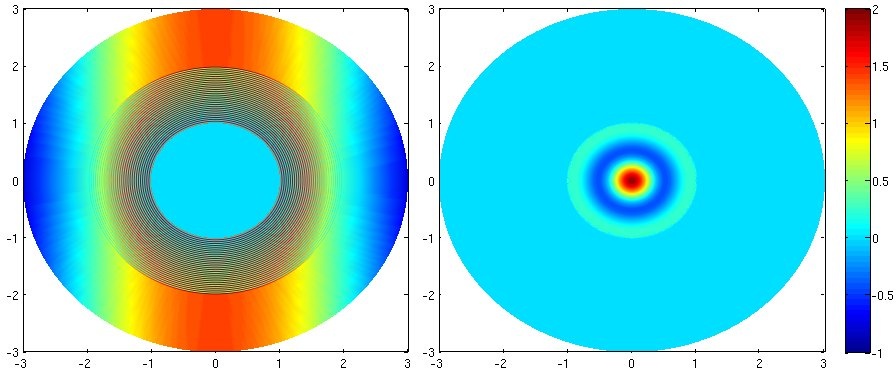
Examples | Youtube videos | Press releases | News | Publications

Figure 1: The invisibility cloaking means coating of an object with a special material so that light goes around the object. Then the coated object is invisible. The figure shows the behavior of the light rays around a coated ball. Only the ball and the light rays are shown in the figure but not the special coating. Today, the required coatings can be made for electromagnetic waves with a single frequency using metamaterials. No material can bend light in this way with all frequencies.
The invisibility cloaking is a widely studied subject. In 2003 we studied (in [9] and [10] below) inverse problems and constructed counterexamples for the uniqueness. In the present terminology the examples mean the invisibility cloaking for low-frequencies. In mathematical terms, our invisibility cloak was based on stretching of the radial coordinate, r'=r/2+1, and was given by formula

In 2006, invisibility cloaking in practice was proposed by U. Leonhardt and Pendry et al (in the same issue of Science Express, May 25 (2006)) using new metamaterials. Later at the same year, the invisibility cloaking for microwave frequencies was demonstrated by D. Schurig et al (Science Express, October 19 (2006)).


Figure 2: Metamaterials can in theory be used for building an artificial electromagnetic wormhole. It is constructed by coating a hollow cylinder with metamaterial. This makes light with a given frequency to behave as if there would be a wormhole in the space. The left figure shows how light rays pass a wormhole. In the figure the cylindrical body and the light rays are shown but the metamaterial coating is not. The middle part of the wormhole appears to be invisible. This is why Scientific American named the constructed device the Harry Potter's invisible sleeve. The right figure shows a simulation of an artificial wormhole located above a chess board below blue sky.
We emphasize that an artificial wormhole would work only for electromagnetic waves with a specified frequency. Moreover, the wormhole device is just an optical device similar to a lens; It would not be similar to space-time wormholes studied in general relativity.

Figure 3: It is possible to create approximate invisibility cloaks for quantum mechanical waves with a specified energy (that is, for the Schrödinger equation). The left figure shows the real part of the wave function when a quantum mechanical matter wave hits to an approximate cloak.
There are some exceptional energies at which the cloaked region starts to resonate. At these energies, the quantum mechanical invisibility cloak supports almost trapped states. The real part of the wave function is shown in the right figure. Such states corresponds to particles that are trapped inside the cloak for a long time with a very high probability. Applications of approximate quantum cloaks include ion traps, almost invisible to matter waves or customizable to support almost trapped states of arbitrary multiplicity. Possible uses include simulation of abstract quantum systems, magnetically tunable quantum beam switches, and illusions of singular magnetic fields [1,4].
Gunther Uhlmann's talk on the mathematics of invisibility cloaking and a talk on the results of the experiments at the Duke univeristy can be viewed at Youtube.
Mathematicians Find a Way to Hide Waves Inside an Invisible "Hat" by University of Washington, June 2012.
Scientists closer to making invisibility cloak a reality by Society for Industrial and Applied Mathematics (SIAM), March 2009.
Schrodinger's Hat Uses Invisibility to Measure Quantum World, Wired (31 May 2012).
Schrodinger's hat could spy on quantum particles, Physics World (5 June 2012).
Optics: Watch your back, Nature 451, 27-27 (02 Jan 2008).
Metamaterials: Lost in space, Nature Photonics 2, 11-11 (01 Jan 2008).
Light wormholes could wire space invisibly, Nature 450, 330-331 (14 Nov 2007).
Wormholes on Earth?, Physorg.com.
"Wormholes" could be made from exotic materials, Physics World.
"Electromagnetic Wormhole" Could Make Objects Invisible, National Geographic.
Envision This: Mathematicians Design Invisible Tunnel, Scientific American.
New Research Brings Invisibility Tech Into View, WIRED magazine.
Mathematicians conjure up invisibility cloak, UW news.
Mathematic Theory to Increase Power of Invisibility Cloak, CCN magazine.
Papers in international refereed journals. (Following tradition in mathematics, authors in papers are in alphabetical order)
Refereed conference proceedings.
Matti Lassas <Matti.Lassas helsinki.fi>
helsinki.fi>
Sep. 2, 2011